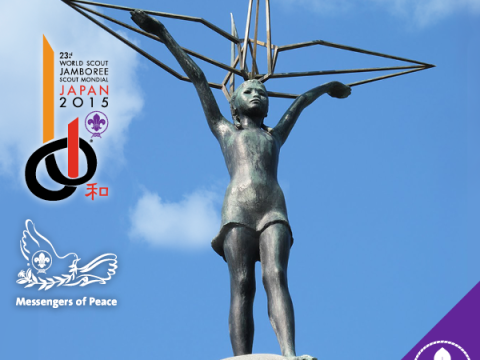This is our cry. This is our prayer. Peace in the world.

Sadako Sasaki was two years old when the atomic bomb was dropped on Hiroshima during World War II. She was less than two kilometres away from where the bomb exploded. Most of Sadako's neighbours died, but she wasn't injured at all, at least not in any way people could see.
She was a normal and happy girl, until the time she was in the seventh grade (1955). Once, after an important relay race that she helped her team win, she felt extremely tired and dizzy. After a while, the dizziness went away, leaving her to think that it was only the exertion from running the race that had made her tired and dizzy.
Soon after her first encounter with extreme fatigue and dizziness, she experienced more similar incidents. One day, she became so dizzy that she fell down and couldn’t get up, and her schoolmates had to inform her teacher. Later, her parents took her to the Red Cross Hospital to find out what was wrong with her. It was then that they found out that she had leukemia, a kind of blood cancer.
At that time, leukemia was known as the “A-bomb disease” because it was caused by radiation exposure from the atomic bomb. Since almost everyone who got this disease died, she was very scared. Although she wanted to go back to school, she had to stay in the hospital.
When her best friend, Chizuko, came to visit her, she brought some origami folding paper. She told Sadako of the legend of the crane, a sacred bird in Japan. If a sick person were to fold 1000 paper cranes, she or he would get well. After hearing that, Sadako decided to fold 1000 paper cranes.
Her family was very concerned about her. They visited her in the hospital frequently to talk to her and help her fold paper cranes. After she had folded 500 cranes, she felt better and the doctors said she could return home for a short time, but by the end of the first week back home, the dizziness and fatigue returned and she had to return to the hospital.
She kept folding paper cranes and tried to be cheerful and hopeful, even though she was in great pain. Unfortunately, not long afterwards, with her family by her bedside, she went to sleep peacefully, never to wake up again. Although she had only managed to fold a total of 644 paper cranes, she was buried with all 1000 cranes – her friends made the rest of the cranes.
Thirty-nine of her classmates, who were saddened by the loss of their close friend, decided to form a paper crane club in her memory. Word spread quickly and as a result, students from 3100 schools and nine foreign countries gave money for the construction of a monument.
On 5 May 1958, the Children’s Peace Monument was built in honour of Sadako. It is located in the centre of Hiroshima Peace Memorial Park, close to the spot where the atomic bomb was dropped. At the bottom of monument, it is engraved - "This is our cry. This is our prayer. Peace in the world".
On 6 August 2015, Scouts participating in the 23rd World Scout Jamboree (#wsj2015) in Japan will visit the Hiroshima Peace Memorial Park to present the paper cranes that they have folded. Regardless of where you will be, be part of this event; fold as many paper cranes as possible and upload your Paper Cranes for Peace selfies at http://photomissions.scout.org/missions/1000-paper-cranes-for-peace/ today. Support our wish for peace!
Source:
http://www.hiroshima-is.ac.jp/index.php?page=sadako-story
http://traditionscustoms.com/lifestyle/senbazuru